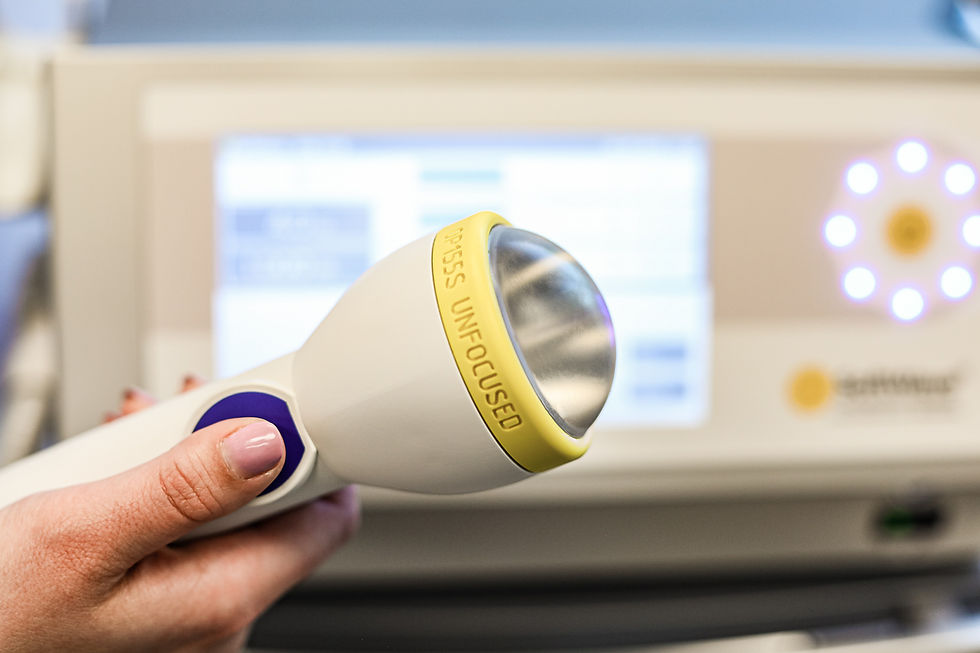Regenerative Healing Without Injections: The Science Behind SoftWave Therapy
- Restoration Chiropractic

- Jul 18
- 3 min read
In the world of modern medicine and sports recovery, a revolutionary technique is emerging that taps into the natural power of sound—SoftWave Therapy. This non-invasive treatment utilizes acoustic wave technology to support cellular regeneration, offering a promising option for athletes dealing with chronic pain, inflammation, and tissue injuries. This blog post explores the science behind SoftWave Therapy, the process of mechanotransduction, and its notable benefits for common injuries, particularly those affecting the knees, shoulders, and conditions like neuropathy.
Understanding SoftWave Therapy
SoftWave Therapy focuses on utilizing sound waves to stimulate healing in targeted areas of the body. Unlike traditional methods that often involve needles or medication, SoftWave uses acoustic waves to promote recovery without the discomfort of injections or invasive procedures.
The foundation of SoftWave Therapy lies in mechanotransduction—the way cells convert mechanical stimuli into biochemical signals. These signals are essential for multiple cellular functions, including inflammation control, repair, and growth. By applying targeted sound waves, SoftWave Therapy enhances the body’s innate healing processes, making it a cutting-edge option for recovery.
The Science of Mechanotransduction
How It Works
Mechanotransduction is crucial for cell growth and tissue healing. Applying mechanical forces to cells triggers receptor activation and promotes the healing process.
In SoftWave Therapy, precise acoustic waves penetrate deep into tissues, creating microtraumas that stimulate the body’s repair systems. For athletes, this is particularly vital, as it allows for quicker recovery from injuries that demand swift healing.
The Role of Extracellular Matrix
An important component of mechanotransduction is the extracellular matrix (ECM). This network of proteins and carbohydrates provides structural support to surrounding cells. Acoustic waves from SoftWave Therapy activate the ECM, encouraging cellular responses that facilitate the regeneration of damaged tissues and improve overall healing.
Clinical Research and Outcomes
FDA Clearances
SoftWave Therapy has been cleared by the FDA, confirming it as a safe and effective treatment for various conditions. This regulatory endorsement is based on numerous clinical studies that highlight the therapy's ability to promote healing and relieve pain.
Published Data on SoftWave Therapy
Recent clinical trials provide compelling data on SoftWave Therapy's effectiveness. For instance, a study published in the Journal of Orthopaedic Research reported that patients with chronic knee pain experienced a 30% reduction in pain levels after just a few SoftWave sessions.
In another study documented in Physical Therapy Reviews, athletes with shoulder injuries showed a 25% increase in range of motion and faster healing times after undergoing SoftWave treatments. These findings suggest significant benefits for active individuals.
Additionally, patients with neuropathy experienced a remarkable 40% reduction in pain and a noticeable improvement in their quality of life following SoftWave therapy, illustrating its effectiveness for various injuries and conditions.
Targeted Benefits for Athletes
Alleviation of Chronic Pain
Athletes often endure chronic pain that can hinder performance. SoftWave Therapy is particularly effective for conditions like tendonitis and ligament injuries. By reducing inflammation—a major contributor to chronic pain—athletes can decrease their reliance on pain medication and manage their discomfort through natural means.
Reducing Inflammation
Inflammation poses a significant challenge for athletes, especially after rigorous training or injuries. SoftWave Therapy helps alleviate inflammation by promoting cell repair and lowering pro-inflammatory cytokine levels. This benefit leads to quicker recovery times, allowing athletes to maintain training without extensive downtime.
Accelerated Tissue Healing
SoftWave Therapy fosters accelerated healing of tissues. By enhancing cellular activity, it supports angiogenesis (the formation of new blood vessels) and boosts collagen production. Both of these processes are critical for effective tissue repair. Athletes attending therapy sessions post-injury can significantly enhance their recovery and return to their peak performance levels faster.
Case Studies and Testimonials
Several athletes have publicly shared their experiences with SoftWave Therapy. For instance, a well-known professional athlete reported substantial relief from recurring knee pain after just a handful of sessions, enabling them to return to their sport more quickly.
Another athlete mentioned significant improvements in shoulder mobility, attributing their enhanced performance directly to the benefits gained from SoftWave Therapy. Testimonials like these, backed by growing clinical evidence, reinforce the potential of acoustic therapy in sports medicine.
Transformative Approaches in Healing
SoftWave Therapy represents a groundbreaking approach to regenerative healing without the need for injections. By leveraging the body's natural mechanisms through an established scientific method like mechanotransduction, it offers a practical solution for athletes battling chronic pain, inflammation, and tissue damage.
With FDA clearances and ongoing research affirming its effectiveness, SoftWave Therapy is emerging as a vital tool for athletes seeking expedited recovery and improved performance. As research continues to unveil its advantages, this innovative therapy is likely to expand its reach in sports medicine and rehabilitation.

For athletes exploring non-invasive healing options, SoftWave Therapy could be a valuable addition to their recovery plans. Its promising applications for both minor injuries and chronic conditions underscore the advancements made in acoustic wave technology, heralding a new era in regenerative medicine.







Comments